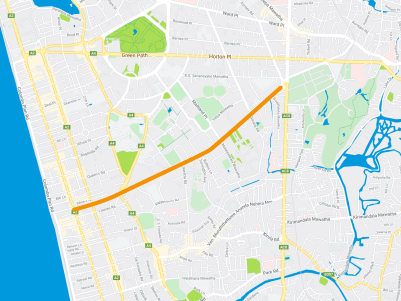Ananda Coomaraswamy Mawatha
GREEN PATH (1770)
The first cinnamon plantation was established in Colombo, in 1770, during Dutch Governor Falck’s tenure. This plantation extended over 12 square miles, from Maradana to Havelock Town. The Dutch built a road, from the middle of this plantation to Galle Road, to transport the cinnamon harvest to the Colombo harbour. They named it Groene Weg and later the British continued to use the name in its English translation, Green Path. This is one of the oldest roads in Colombo.
ANANDA COOMARASWAMY MAWATHA (circa 2010)
Ananda Kentish Muthu Coomaraswamy (1877 - 1947) was a pioneering historian and philosopher of South Asian art, literature, and religion. His articles and the influential role he played as the curator of the Asian Art collection of the Museum of Fine Arts, Boston enabled him to introduce Asian art to the West. Born in Sri Lanka, his father was a Tamil statesman, Sir Muthu Coomaraswamy, and his mother, Elizabeth Beeby, was English. The Dance of Shiva and Sinhalese Medieval Art are his most prominent works.
NELUM POKUNA MAWATHA (2011)
Ananda Coomaraswamy Mawatha was named Nelum Pokuna Mawatha when the Nelum Pokuna Mahinda Rajapaksa Theatre was opened on 15th December 2011. The theatre’s architectural style is inspired by the 12th century eight-petaled, five-tiered granite Lotus Pond (Nelum Pokuna) located in Polonnaruwa and believed to have been built by King Parakramabahu the Great.
ANANDA COOMARASWAMY MAWATHA (2015)
This road was renamed back to Ananda Coomaraswamy Mawatha on 10th February 2015 by President Maithripala Sirisena.
Who was Ananda Coomaraswamy and what was his contribution to Sri Lankan Academia?
Ananda Kentish Coomaraswamy (1877-1947) was one of the great art historians of the twentieth century whose multifaceted writings deal primarily with visual art, aesthetics, literature and language, folklore, mythology, religion, and metaphysics. His most mature works adeptly expound the perspective of the perennial philosophy by drawing on a detailed knowledge of the arts, crafts, mythologies, cultures, folklores, symbolisms, and religions of both the East and the West. Along with René Guénon and Frithjof Schuon, Ananda Coomaraswamy is considered as a leading member of the Traditionalist or Perennialist school of comparative religious thought. In studies like Medieval Sinhalese Art (1908), The Arts and Crafts of India and Ceylon (1913), and his earliest collection of essays, The Dance of Shiva (1918), Coomaraswamy combated the prejudices of the age and reaffirmed traditional understandings of Indian art.
Ananda Coomaraswamy Mawatha
Who was Ananda Coomaraswamy and what was his contribution to Sri Lankan Academia?
Ananda Kentish Coomaraswamy (1877-1947) was one of the great art historians of the twentieth century whose multifaceted writings deal primarily with visual art, aesthetics, literature and language, folklore, mythology, religion, and metaphysics. His most mature works adeptly expound the perspective of the perennial philosophy by drawing on a detailed knowledge of the arts, crafts, mythologies, cultures, folklores, symbolisms, and religions of both the East and the West. Along with René Guénon and Frithjof Schuon, Ananda Coomaraswamy is considered as a leading member of the Traditionalist or Perennialist school of comparative religious thought. In studies like Medieval Sinhalese Art (1908), The Arts and Crafts of India and Ceylon (1913), and his earliest collection of essays, The Dance of Shiva (1918), Coomaraswamy combated the prejudices of the age and reaffirmed traditional understandings of Indian art.
Nelum Pokuna Mawatha
Ananda Coomaraswamy Mawatha
Who was Ananda Coomaraswamy and what was his contribution to Sri Lankan Academia?
Ananda Kentish Coomaraswamy (1877-1947) was one of the great art historians of the twentieth century whose multifaceted writings deal primarily with visual art, aesthetics, literature and language, folklore, mythology, religion, and metaphysics. His most mature works adeptly expound the perspective of the perennial philosophy by drawing on a detailed knowledge of the arts, crafts, mythologies, cultures, folklores, symbolisms, and religions of both the East and the West. Along with René Guénon and Frithjof Schuon, Ananda Coomaraswamy is considered as a leading member of the Traditionalist or Perennialist school of comparative religious thought. In studies like Medieval Sinhalese Art (1908), The Arts and Crafts of India and Ceylon (1913), and his earliest collection of essays, The Dance of Shiva (1918), Coomaraswamy combated the prejudices of the age and reaffirmed traditional understandings of Indian art.




